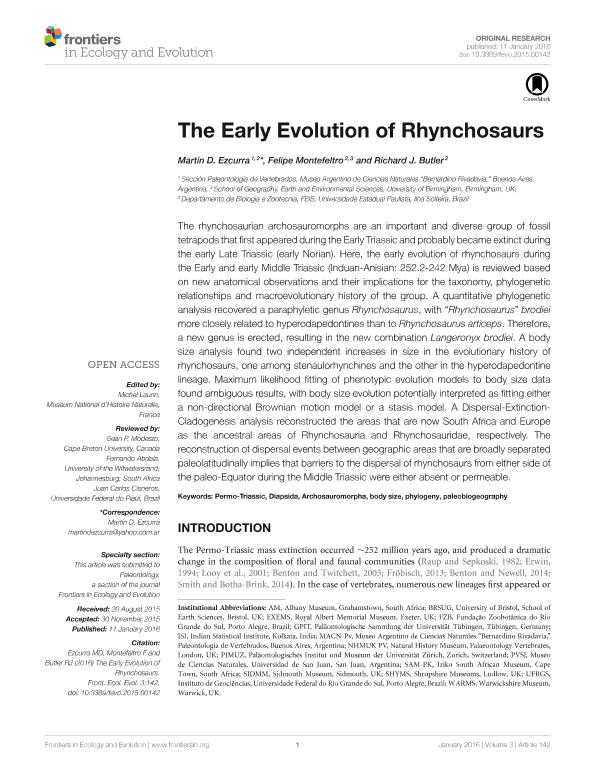Mostrar el registro sencillo del ítem
dc.contributor.author
Ezcurra, Martin Daniel

dc.contributor.author
Montefeltro, Felipe C.
dc.contributor.author
Butler, Richard J.
dc.date.available
2018-05-03T19:48:47Z
dc.date.issued
2016-01
dc.identifier.citation
Ezcurra, Martin Daniel; Montefeltro, Felipe C.; Butler, Richard J.; The Early Evolution of Rhynchosaurs; Frontiers; Frontiers in Ecology and Evolution; 3; 142; 1-2016; 1-23
dc.identifier.issn
2296-701X
dc.identifier.uri
http://hdl.handle.net/11336/44040
dc.description.abstract
The rhynchosaurian archosauromorphs are an important and diverse group of fossil tetrapods that first appeared during the Early Triassic and probably became extinct during the early Late Triassic (early Norian). Here, the early evolution of rhynchosaurs during the Early and early Middle Triassic (Induan-Anisian: 252.2-242 Mya) is reviewed based on new anatomical observations and their implications for the taxonomy, phylogenetic relationships and macroevolutionary history of the group. A quantitative phylogenetic analysis recovered a paraphyletic genus Rhynchosaurus, with “Rhynchosaurus” brodiei more closely related to hyperodapedontines than to Rhynchosaurus articeps. Therefore, a new genus is erected, resulting in the new combination Langeronyx brodiei. A body size analysis found two independent increases in size in the evolutionary history of rhynchosaurs, one among stenaulorhynchines and the other in the hyperodapedontine lineage. Maximum likelihood fitting of phenotypic evolution models to body size data found ambiguous results, with body size evolution potentially interpreted as fitting either a non-directional Brownian motion model or a stasis model. A Dispersal-ExtinctionCladogenesis analysis reconstructed the areas that are now South Africa and Europe as the ancestral areas of Rhynchosauria and Rhynchosauridae, respectively. The reconstruction of dispersal events between geographic areas that are broadly separated paleolatitudinally implies that barriers to the dispersal of rhynchosaurs from either side of the paleo-Equator during the Middle Triassic were either absent or permeable.
dc.format
application/pdf
dc.language.iso
eng
dc.publisher
Frontiers
dc.rights
info:eu-repo/semantics/openAccess
dc.rights.uri
https://creativecommons.org/licenses/by/2.5/ar/
dc.subject
Permo-Triassic
dc.subject
Diapsida
dc.subject
Archosauromorpha
dc.subject
Body Size
dc.subject
Phylogeny
dc.subject
Paleobiogeography
dc.subject.classification
Meteorología y Ciencias Atmosféricas

dc.subject.classification
Ciencias de la Tierra y relacionadas con el Medio Ambiente

dc.subject.classification
CIENCIAS NATURALES Y EXACTAS

dc.title
The Early Evolution of Rhynchosaurs
dc.type
info:eu-repo/semantics/article
dc.type
info:ar-repo/semantics/artículo
dc.type
info:eu-repo/semantics/publishedVersion
dc.date.updated
2018-04-27T18:51:35Z
dc.journal.volume
3
dc.journal.number
142
dc.journal.pagination
1-23
dc.journal.pais
Suiza

dc.journal.ciudad
Lausana
dc.description.fil
Fil: Ezcurra, Martin Daniel. University of Birmingham; Reino Unido. Consejo Nacional de Investigaciones Científicas y Técnicas. Oficina de Coordinación Administrativa Parque Centenario. Museo Argentino de Ciencias Naturales "Bernardino Rivadavia"; Argentina
dc.description.fil
Fil: Montefeltro, Felipe C.. University of Birmingham; Reino Unido. Universidade Estadual Paulista Julio de Mesquita Filho; Brasil
dc.description.fil
Fil: Butler, Richard J.. University of Birmingham; Reino Unido
dc.journal.title
Frontiers in Ecology and Evolution
dc.relation.alternativeid
info:eu-repo/semantics/altIdentifier/doi/http://doi.org/10.3389/fevo.2015.00142
dc.relation.alternativeid
info:eu-repo/semantics/altIdentifier/url/https://www.frontiersin.org/articles/10.3389/fevo.2015.00142/full
Archivos asociados
